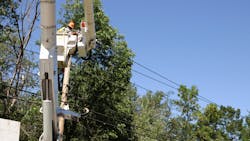America just hit a first anniversary COVID-19 pandemic milestone when most of our country was asked to “stand down” and “work remotely” if we could. We were all asked, as Americans, to do what we could to protect the vulnerable and protect each other. Amid all that “new normal” we were being forced to endure, our essential workforce didn’t blink an eyelid at the challenge. These outstanding men and women understood that if we didn’t do our part to help keep the electrical grid functional for all the remote workers out there, what we had left of an economy would be at risk.
The utility vegetation management (UVM) workforce is comprised of some of the strongest, brightest and most resilient professionals who I have ever had the opportunity to work around. The work we all do to support our electrical systems throughout North America often goes unnoticed until something goes wrong. The vast majority of the UVM workforce, including their leadership, who I have had the pleasure of working with, take a lot of pride in maintaining rights-of-ways for the benefit of the electrical grid and the general public it supplies. There also is no shortage of a lot of pride associated with being good stewards of our environment and constantly taking on the challenge of working smarter and safer without having to work harder.
Focusing on Diversity
One of the ways that we have gotten to where we are today in our industry is that we embrace and celebrate diversity and inclusion. It really wasn’t that long ago when the UVM industry was primarily a male-dominated industry. Research, educational diversity, and technology have really opened a lot of doors for a lot of very bright people in the last decade or so. Progress has been made; however, continuous improvement is a model we need to follow.
I’m also amazed at the collaborative efforts of many and the lessons that we all have learned from this pandemic. For example, networking and continuing education was mostly achieved at face-to-face conferences and meetings. I’m of the generation who learns well that way, but my younger counterparts have shown me that we can adapt and still develop the knowledge and relationships that we all seek and even do it virtually if we have to. We should recognize and appreciate this generational diversity for what it is so we can carry forward those lessons learned to make our industry even stronger tomorrow.
Improving Leadership
There are several keys to success in developing a successful workforce culture, however, two of them must continue to be strong if we are going to strive for continuous improvement. The first is leadership, and the second is really being able to understand what makes a happy employee.
Leadership means a lot of different things to a lot of different people. Ask yourself the following questions as a self-assessment to see if you need to adjust to make your team(s) more successful than they already are.
Do you have the ability to simplify things so the “asks,” “expectations,” or “plans” are easily understood? Do you feel like you have the urge to be the smartest person in the room? As a leader, do you give credit where credit is due? Do you, as a leader, support open and honest communication no matter how hard it may be to hear?
Boosting Job Satisfaction
It is critical to a workforce culture that you are able to figure out what employees want to be happy. Now, you might be inclined to think that money is at the top of everyone’s list, but people just want to feel relevant and don’t want to be anonymous, according to Patrick Lenciono’s book, The Three Signs of a Miserable Job. Everyone wants to be recognized for their efforts. It can be really demoralizing when the leader takes all the credit for the success of the team because of his or her presumed leadership abilities. Lastly, everyone wants to be measured fairly.
The last 12 months have been unprecedented in terms of what we expected out of it, and what we ended up with. I do not know of anyone who could predict where this pandemic has taken us.
Our talented men and women are essential to our workforce and have done an outstanding job of adapting and adjusting during these trying times. Furthermore, our diversity and continuous efforts to include and collaborate is really our strength as an industry. And lastly, even though we may have made the best out of a bad situation, there is always room to self-reflect and improve.
Paul Hurysz ([email protected]) is president of the Utility Arborist Association.
About the Author
Paul Hurysz
Paul Hurysz ([email protected]) is president of the Utility Arborist Association.
